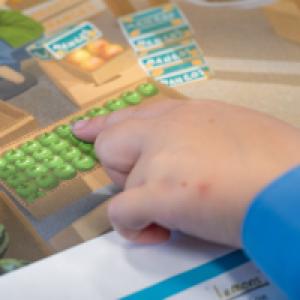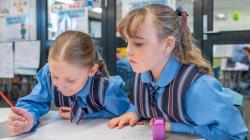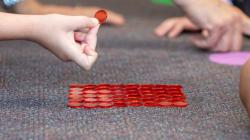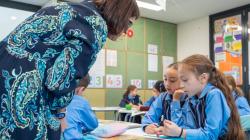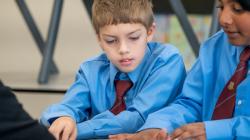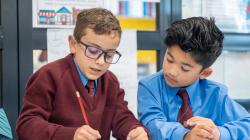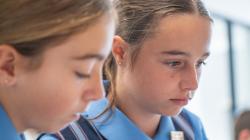'Multiplication: reSolve Market' is one of our new teaching sequences for V9
- On the 'In this sequence' tab you'll find all the lessons in this sequence, a suggested implementation plan and curriculum alignment.
- The 'Behind this sequence' tab shows how key mathematical ideas develop over the sequence.
- Have you taught this sequence? Use the Feedback button to let us know how it went!
Tasks in this sequence
Task 1 • Finding multiplication
Students learn that multiplication is about ‘how many’ groups and ‘how much’ in each group.
Task 2 • Mangoes and apples
Students learn that the array is a powerful representation of the ‘how many’ groups and ‘how much in each group’ structure of multiplication.
Task 3 • Making arrays
Students complete an activity that builds their understanding of the array as a representation of multiplication.
Task 4 • Hidden fruit
Students learn that multiplying ‘how many’ by ‘how much’ gives the whole.
Task 5 • Rolling arrays
Students play a game to build their understanding that multiplying how many by how much gives the whole.
Task 6 • Lemon arrays
Students learn that related multiplication and division facts can be recorded as a fact family.
Task 7 • Making fact families
Students continue to build their understanding that related multiplication and division facts can be recorded as a fact family.
Task 8 • Finding fact families
Students revisit the reSolve Market picture and use fact families to record the multiplication.
Sequence implementation
This time plan is just one way that you might choose to implement this sequence. We have based this plan on 50-minute lessons, with some tasks split across two lessons. The timing provided in the tasks’ documentation align with this implementation advice.
| Week 1 | Week 2 | |
|---|---|---|
| Monday | Task 1 • Finding multiplication
| Task 6 • Lemon arrays
|
| Tuesday | Task 2 • Mangoes and apples
| Task 6 • Lemon arrays
|
| Wednesday | Task 3 • Making arrays
| Task 7 • Making fact families
|
| Thursday | Task 4 • Hidden arrays
| Task 8 • Finding fact families
|
| Friday | Task 5 • Rolling arrays
| Task 5 • Rolling arrays
|
Curriculum and syllabus alignment
Achievement standards
Students use mathematical modelling to solve practical problems involving single—digit multiplication and division, recalling multiplication facts for twos, threes, fours, fives and tens, by using a range of strategies.
Australian Curriculum V9 alignment
Number
Multiply and divide one- and two-digit numbers, representing problems using number sentences, diagrams and arrays, and using a variety of calculation strategies
Algebra
Recall and demonstrate proficiency with multiplication facts for 3, 4, 5 and 10; extend and apply facts to develop the related division facts
Sequence design overview
Multiplication involves students being able to recognise and work with equal-sized groups, and to differentiate between how many and how much (Siemon et al, 2021). This sequence uses the array as a powerful model to express the distinction between how many and how much, which forms the foundation for the idea of factor-factor-product. This supports student understanding of the relationship between multiplication and division and informs the building of fact families.
How many and how much: In multiplication, students need to work out two things: ‘how many groups’ and ‘how much in each group’. Students need to be able to distinguish between the two quantities which make up the whole. The two-dimensional nature of the array makes the distinction between these quantities visible, as the count of how many indicates the number of rows, where the count of how much indicates the number in each row.
Fact families: Multiplication and division are about equal-sized groups. The two operations are related, which means that when we know one fact, we actually know four (for square numbers there are just two). The array powerfully represents the relationship between multiplication and division, as it makes the factor-factor-product idea visible.
Sequence Framework
This Sequence Framework presents an overview of the key elements in this sequence.
| Learning goals | Students’ mathematical activity | Representation | Context | |
|---|---|---|---|---|
| Task 1 | Multiplication is about coordinating two ideas: how many groups and how much in each group. | Students identify examples of multiplication in the reSolve Market picture, including examples of equal groups and arrays. | Multiplication is represented as equal-sized groups and arrays. | The reSolve Market is introduced through an illustration with examples of multiplication as equal-sized groups and arrays. |
| Task 2 | The array powerfully represents the ‘how many groups’ and ‘how much in each group’ structure of multiplication. | Students investigate relationships between different collections of fruit represented in equal groups and the array. | Multiplication is represented as equal-sized groups and arrays. The different representations have been carefully designed to illustrate properties and relationships. | The different displays of fruit have been carefully designed to model multiplicative properties and relationships. |
| Task 3 | The array powerfully represents the ‘how many groups’ and ‘how much in each group’ structure of multiplication. | Students create arrays for a given total and investigate the relationship between how many rows and how much in each row. | Students create their own arrays given how many and how much. | A Build activity in which students create their own arrays and record the corresponding multiplication fact. |
| Task 4 | Multiplying how many by how much gives the whole: how many x how much = the whole | Students calculate the amount of fruit in partially hidden arrays. They work out how many and how much to find the whole. | Partial arrays and hidden groups build the relationship between:
| The back of the reSolve Market with boxes partially unpacked or hidden. |
| Task 5 | Multiplying how many by how much gives the whole: how many x how much = the whole | Students create arrays and record corresponding multiplication facts through the context of a game. | Students create an array based on how many and how much and record this as a multiplication fact. | A game to build students’ understanding of the relationship between how many, how much, and the whole. |
| Task 6 | Related multiplication and division facts can be recorded as a fact family. A family of facts is clearly modelled in the array. | Students organise equal-sized bags of fruit into different arrays. They determine the family of facts that are represented by each array. | Multiple equal-sized bags converted into arrays, recording the corresponding fact family for each array. | Equal-sized bags of lemons, limes and kiwifruit are unpacked by the grocer to display as an array in the Market store. |
| Task 7 | Related multiplication and division facts can be recorded as a fact family. A family of facts is clearly modelled in the array. | Students create arrays for a given total and record the family of facts that are represented by each array. | Students create arrays based on how many and how much and record the corresponding fact family. | A Build activity in which students create their own arrays and record the corresponding fact family. |
| Task 8 | Related multiplication and division facts can be recorded as a fact family. | Students revisit the reSolve Market picture and record the fact families for the different examples of multiplication that can be seen. | Return to the example of multiplication in the reSolve Market and recording corresponding fact families. | Return to the example of multiplication in the reSolve Market and recording corresponding fact families. |
